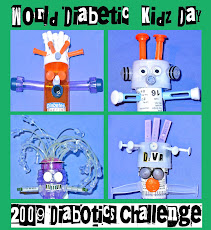A diabotic is a creature made from recycled diabetes supplies (see the last post about terminology) who possesses, additionally, a superpower assigned by its creator (diabetologist of origin). Making diabotics is a meant to be a fun, all-inclusive activity open to any interested individual, requiring simply recycled diabetes-related materials, with no specific tools needed and involving minimal cost (glue). The enthusiastic diabetologist may want to stop reading here and dash off to begin his or her own adventures in this domain. Others may wish to read these basic ideas for making diabotics that emerged from our own explorations.
Starting Materials
The building blocks of diabotics are (1) any waste materials that arise during day to day diabetes management and (2) some of joining them together, such as glue. The possibilities are diverse and everyone is encouraged to explore this further. Different materials will be available to each person, based on his or her unique treatment plan (oral medication, insulin shots or pump). The essential thing is that "every patient tests and every patient treats" (and, thus, "diabetes waste happens"). You may also find it satisfying, as we did, to smash used items. Here are some items to consider using as pieces for making diabotics:
Glucose and ketone monitoring supplies: discarded lancets and lancet packaging, discarded strips, alcohol swab packaging, broken lancing devices, plastic bottles of glucometer calibration fluid, used glucometer batteries
Used or expired medication bottles or packaging: Used or expired insulin bottles, used glucagon bottles or kits, used pill bottles, used glucose tablet or glucose gel packaging
Used syringes, used pumping supplies, used glucometers: Site change devices and packaging, pump tubing, pump insulin syringes, used pump batteries
There are other areas to explore, as well, such as materials involved in recording glucose values (old log books, notebooks sent to school with lunch carb values, outdated cables for uploading glucometer values to computers), materials used in sharps collection and in hand sanitizing. It will be different for each individual. The most pressing issue that must be carefully and thoroughly addressed before starting any diabotics project is safety.
Safety Issues
- Sharp surfaces, glass - Carefully remove all sharp elements. This includes needle tips on lancets and on insulin syringes. Examine site applicators to make sure that no sharps will extrude if the device is pushed into the application position by small hands.Take a careful look at all the edges of site applicators and similar items (syringes, etc). Even plastic can have broken edges. The use of breakable expired insulin bottles should, in our humble opinion, be supervised by an adult and omitted from the diabotology palette of younger children.
- Contamination - Anything that has potentially come into contact with bodily fluids should be treated with something to eliminate the possibility of transmitting an infective illness. We put these in a bowl of dilute bleach solutionn (1 tbsp per gallon) overnight. Anything that doesn't require this step gets a thorough wash with soapy hot water.
We recommend decontaminating and extracting sharps as soon as you begin collecting your materials (and then regularly as you go along).It saves the extra work (and needle stick risks) of sorting through used diabetes materials.
Getting Down to Business:
- Find a sizeable flat surface to spread out materials on where glue spillage will not be an issue (use newspaper, trash bags or plastic tablecloths, if needed). Garb youngsters as indicated on their "messiness with crafts" scale rating (one being that mythical perfect child, ten the glue "hurler").
- Play with pieces and see what evolves. Certain items might snap together. You might consider taking apart site applicators or old glucometers to see what is inside. Ellie, below, is coloring her diabotic's eyes with a Sharpie.
- Join, glue, wire, solder, melt to your heart's content. (Those interested in more detailed notes regarding our personal experiences may want to read the Supplementary Information post to follow). Anika, below, finds yet another use for the Dremel tool in Diabotic Engineering (reviewed in Supplementary Info post).
- Explore the identity of your diabotic, choosing its name and superpower (see additional information the following Diabotic Identity post).
- Consider submitting your diabotic to the landmark first World Diabetic KID'Z Day Global Diabotics Challenge (see the upcoming Diabotics Challenge post for specifics).
Diabotics = Diabetic Waste Joined Together Somehow
The most important message we want to communicate is that diabotics are created by whatever works. Making these creatures is a way to have fun, spend time together, re-purpose waste and raise diabetes awareness, all at very little cost. The above is meant to offer some ideas and inspire individuals to begin their own journeys. It's important not to let "stuff", get in the way of "doing". As many great people have stated throughout history: "The most important things in life are not things."














No comments:
Post a Comment